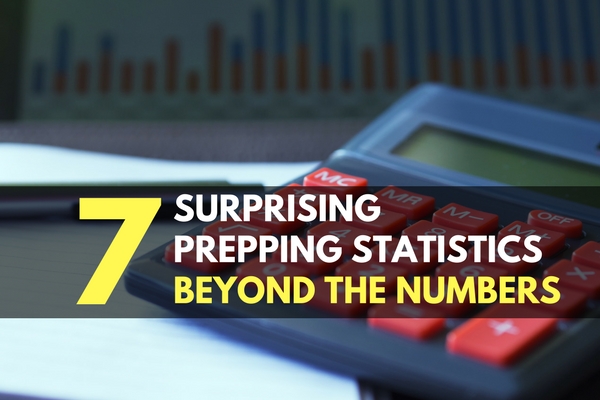2024 Prepping Statistics and Demographics
There are several sources of data for prepping, survival, and preparedness but they all have their own limitations. Limited sample sizes, responses, and dirty data can happen with any study. This is why many of the statistics and data-derived information you find for cultural responses can vary so much between sources. We’ve conducted our own surveys and have seen the challenges first-hand.
To overcome this variance between sources, we’ve opted to start aggregating sources for this statistics and demographics roundup. Combining multiple studies (and population samples) is much more statistically significant than relying on a single study. Many of the studies we’ve been keeping our eyes on ask similar questions anyway- so it just comes down to someone to collate and interpret the lake of data.
And that’s where we come in. We’ve crunched the numbers from all of the most recent surveys (including our own) and combined them into easy-to-follow prepping statistics, demographics, and facts.
Stat 1: Federal spending on disasters increased 6698% from 1953 to 2009 (1)
Going well past any possible increase in disaster exposure, population growth, and inflation- this giant growth can be attributed to a cultural change that has devalued the importance of prepping and preparedness. In 1953 there were no ‘preppers’- only everyday people living their lives according to the risks they knew rather than the risks they chose to ignore.
Stat 2: Only 39% of individuals have a basic emergency plan (2)
This means that 61% of people have not discussed what they will do even if a simple house fire occurs. If you don’t have a basic emergency plan, increase this statistic and print our easy-to-use template for free: TruePrepper Basic Emergency Plan
Stat 3: 75% of health care workers claim to be unprepared (2)
This is surprising considering that these are the same people who see the impact of disasters and emergencies all the time. People who understand the fragility of the human body would seemingly take care to prepare for emergencies, and especially pandemics, in their situation.
Stat 4: 44% of Americans don’t have first-aid kits in their homes (3)
This statistic just seems crazy. First aid kits are so cheap and readily available; I just take for granted that most homes would have these. I would be interested to see this stat for other countries to see if it goes up or down.
Stat 5: The survival rate for CPR has been calculated at 20% (4)
While it may seem low, ‘shockable treatment’ is at a whopping 57% survival rate. This is a good reason why AEDs are a good investment for first responders, businesses, and communities. Even the 20% survival rate is great when compared to 0% when you are untrained in CPR.
Stat 6: 42% of Americans do not know an immediate family member’s phone number (5)
While this sounds ridiculous, most people rely on their cell phones and the one-touch dial to contact each other. Learning an “ICE (In Case of Emergency)” phone number and making an emergency contact list is a great way to get prepared for any simple emergency.
Stat 7: Over half of Americans do not have copies of their critical documents (3)
Social Security cards, birth certificates, passports, and photo IDs are all important to have if you are bugging out, displaced, or just need them in an emergency. Waterproof and even better: fireproof pouches are great for stashing these items where you can grab them in a hurry.
Prepping Statistics and Demographics Sources
It’s always a good idea to grab info from a variety of reliable sources, regardless of your end goal. We got our stats from these surveys, papers, and books:
- Disaster Resilience: A National Imperative (Print Book) by National Academies, Committee on Science, Engineering, and Public Policy.
- FEMA National Household Surveys Data
- CDC surveys
- AHA statistics
- Pew Research Center
The Final Word
Statistics can either be boring and mundane or a tool you can use to convince others of the importance of prepping. Some do not care for the numbers or the bigger picture and are better swayed by anecdotal stories. This is where sharing your own experiences can help. I prefer to use numbers and my personal experiences together to share how important being prepared actually is.
Keep exploring, stay prepared, and be safe.
You’ve Been Missing Out
Join the 2+ million preppers that rely on our prepping advice by subscribing to TruePrepper.- Practical guides and tips
- Useful survival giveaways
- Free, forever
- < 0.4% of people unsubscribe



These stats are powerful and a little disturbing. People are too dependent in the infrastructure that will fail in a SHTF situation. Great post. I plan to do a few things after reading. First get important contact information on a card that each family member can keep other than on their smartphones. Also buy a few extra first aid kits. :)